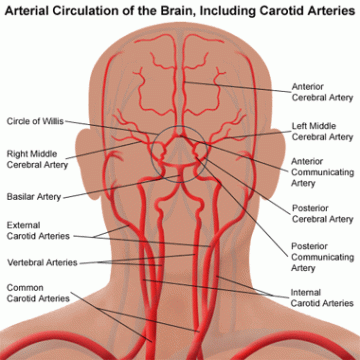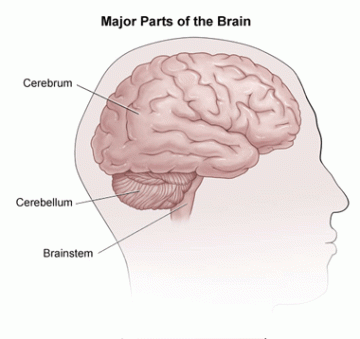What is a Stroke?
Find your care
Our specialists offer the full range of inpatient and outpatient stroke and vascular neurology services.
To learn more, please call 310-794-1195.
Frequently asked questions

- What is a stroke?
- What are the effects of stroke?
- What effects can be seen with a stroke in the cerebrum?
- Effects of a right hemisphere stroke in the cerebrum
- Effects of a left hemisphere stroke in the cerebrum
- What effects can be seen with a stroke in the cerebellum?
- What effects can be seen with a stroke in the brain stem?
What is a stroke?
Stroke, also called brain attack, occurs when blood flow to the brain is disrupted. Disruption in blood flow is caused when either a blood clot or piece of plaque blocks one of the vital blood vessels in the brain (ischemic stroke), or when a blood vessel in the brain bursts, spilling blood into surrounding tissues (hemorrhagic stroke).
The brain needs a constant supply of oxygen and nutrients in order to function. Even a brief interruption in blood supply can cause problems. Brain cells begin to die after just a few minutes without blood or oxygen. The area of dead cells in tissues is called an infarct. Due to both the physical and chemical changes that occur in the brain with stroke, damage can continue to occur for several days. This is called a stroke-in-evolution and requires close observation.
A loss of brain function occurs with brain cell death. This may include impaired ability with movement, speech, thinking and memory, bowel and bladder, eating, emotional control, and other vital body functions. Recovery from stroke and the specific ability affected depends on the size and location of the stroke. A small stroke may result in problems such as weakness in an arm or leg. Larger strokes may cause paralysis (inability to move part of the body), loss of speech, or even death.
According to the National Stroke Association, it is important to learn the 3 Rs of stroke:
- Reduce the risk.
- Recognize the symptoms.
- Respond by calling 911 (or your local ambulance service).
Stroke is an emergency and should be treated as such. The greatest chance for recovery from stroke occurs when emergency treatment is started immediately.
Effects of stroke (brain attack)
What are the effects of stroke?

The effects of stroke (brain attack) vary from person to person based on the type, severity, location, and number of strokes. The brain is extremely complex and each area of the brain is responsible for a special function or ability. When an area of the brain is damaged, which typically occurs with a stroke, an impairment may result. An impairment is the loss of normal function of part of the body. Sometimes, an impairment may result in a disability, or inability to perform an activity in a normal way.
The brain is divided into three main areas:
- Cerebrum (consisting of the right and left sides or hemispheres)
- Cerebellum
- Brain stem
Depending on which of these regions of the brain the stroke occurs, the effects may be very different.
What effects can be seen with a stroke in the cerebrum?
The cerebrum is the part of the brain that occupies the top and front portions of the skull. It is responsible for control of abilities, such as movement and sensation, speech, thinking, reasoning, memory, vision, and regulation of emotions. The cerebrum is divided into the right and left sides, or hemispheres.
Depending on the area and side of the cerebrum affected by the stroke, any, or all, of the following body functions may be impaired:
- Movement and sensation
- Speech and language
- Eating and swallowing
- Vision
- Cognitive (thinking, reasoning, judgment, and memory) ability
- Perception and orientation to surroundings
- Self-care ability
- Bowel and bladder control
- Emotional control
- Sexual ability
In addition to these general effects, some specific impairments may occur when a particular area of the cerebrum is damaged.
Effects of a right hemisphere stroke in the cerebrum
The effects of a right hemisphere stroke may include the following:
- Left-sided weakness (left hemiparesis) or paralysis (left hemiplegia) and sensory impairment
- Denial of paralysis or impairment and reduced insight into the problems created by the stroke (this is called "left neglect")
- Visual problems, including an inability to see the left visual field of each eye (homonymous hemianopsia)
- Spatial problems with depth perception or directions, such as up or down and front or back
- Inability to localize or recognize body parts
- Inability to understand maps and find objects, such as clothing or toiletry items
- Memory problems
- Behavioral changes, such as lack of concern about situations, impulsivity, inappropriateness, and depression
Effects of a left hemisphere stroke in the cerebrum
The effects of a left hemisphere stroke may include the following:
- Right-sided weakness (right hemiparesis) or paralysis (right hemiplegia) and sensory impairment
- Problems with speech and understanding language (aphasia)
- Visual problems, including the inability to see the right visual field of each eye (homonymous hemianopsia)
- Impaired ability to do math or to organize, reason, and analyze items
- Behavioral changes, such as depression, cautiousness, and hesitancy
- Impaired ability to read, write, and learn new information
- Memory problems
What effects can be seen with a stroke in the cerebellum?
The cerebellum is located beneath and behind the cerebrum towards the back of the skull. It receives sensory information from the body through the spinal cord and helps to coordinate muscle action and control, fine movement, coordination, and balance.
Although strokes are less common in the cerebellum area, the effects can be severe. Four common effects of strokes in the cerebellum include:
- Inability to walk and problems with coordination and balance (ataxia)
- Dizziness
- Headache
- Nausea and vomiting
What effects can be seen with a stroke in the brain stem?
The brain stem is located at the very base of the brain right above the spinal cord. Many of the body's vital "life-support" functions such as heartbeat, blood pressure, and breathing are controlled by the brain stem. It also helps to control the main nerves involved with eye movement, hearing, speech, chewing, and swallowing. Some common effects of a stroke in the brain stem include problems with the following:
- Breathing and heart functions
- Body temperature control
- Balance and coordination
- Weakness or paralysis
- Chewing, swallowing, and speaking
- Vision
- Coma
Unfortunately, death is possible with brain stem strokes.